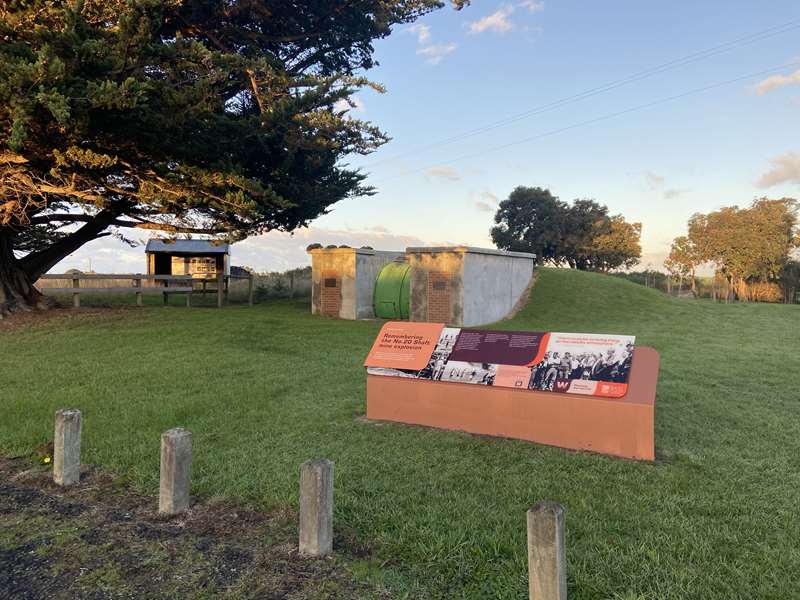Wonthaggi Coal Mine No. 20 Shaft


In its heyday the State Coal Mine was a bustling network of dimly lit underground tunnels filled with men, pit ponies, and dust. Operating from 1909 to 1968, some 17 million tonnes of coal was extracted from the Wonthaggi mines.
The State Coal Mine Historic Area consists of seven separate sites.
A dangerously gassy and dusty mine, No.20 Shaft claimed four lives in an explosion during its first tear of operation. A further explosion killed 13 men in 1937. Hated by most miners, it was rehabilitated after the explosion and worked for a further 25 years.
1937 Mine Explosion Memorial
On February 15th, 1937, a horrific explosion in the No. 20 coal mine shaft of Wonthaggi claimed the lives of 13 men. At 10am, a cloud of coal dust and gas erupted from the shaft, pushing a three ton cage 15 metres above the surface and tearing the roof off an adjoining house. The blast was so powerful that it even caused the shutters of the Dalyston post office, located four kilometres away, to drop.
This tragedy was yet another blow to the community, as four men had already been killed in the mine during it's first year of operations on February 20th, 1931.
Today, we remember the miners who died, as well as the many who risked their lives to enter the toxic and hazardous mine in the hopes of rescuing survivors.
We remember the families who loved them and keep in our hearts and collective memory the tragic loss suffered at this site.
Disaster in No.20 Shaft
"13 MEN TRAPPED BY EXPLOSION IN MINE"
'700ft underground at Wonthaggi"
"GAS-MASKED RESCUERS BATTLE WITH DEBRIS"
"Whole Township Waits"
"MINE MANAGER FIRST INTO WRECKED SHAFT'
On the morning of February 15th 1937, large numbers of mine workers and townsfolk converged at the pit head of No.20 Shaft mine. News spread rapidly that a major underground explosion had occurred, trapping thirteen men.
The mine lay idle on this morning, manned only by a small maintenance crew. The miners were on strike and about to attend a union meeting scheduled for 10:30am, when disaster struck at approximately 10:05am.
Despite tireless rescue efforts, there were no survivors. The body of the first victim, Martin Bowman (Ropeman) was discovered ten hours after the explosion. The body of the last victim, Harry Harper (Overman) was found after eight days of continual searching.
Life in No.20 Shaft
By 1937 the working conditions of No. 20 Shaft mine were of grave concern to mine employees and their families. Men often worked in cramped conditions, with a constant threat of roof falls.
Working conditions were warm and dry, with methane gas and high levels of coal dust being present. Both had the potential to ignite and a gas explosion had killed four men in 1931. Despite this, the miners continued to work with naked flame lamps for lighting.
Although dangerous, mining was the main source of employment in Wonthaggi, with males beginning work as young as fourteen. In later life, miners suffered from a high incidence of emphysema, however strong mateship and unionism helped the mine employees cope with these difficulties.
Tragedy, Heroism, Devotion
On the morning of the disaster, volunteer rescue teams entered the pit equipped with primitive gas masks, safety lamps, caged canaries (to detect poisonous gas) and two stretchers. They were met by utter devastation; steel rails twisted, large timbering dislodged and split to matchwood and huge stone falls blocking progress. Initial rescue efforts were in vain.
By midday, fully trained and organised rescue teams, wearing self-contained breathing apparatus, descended into the pit, still hopeful of finding life. Poisonous gas was encountered as the men progressed, killing many canaries. The potential for father explosions remained, as did the risks of falls of stone.
Behind the rescue teams, dozens of miners worked at clearing and shoring the tunnels and restoring ventilation. Such efforts continued until the last body was found.
The Aftermath
After the disaster, the workers' solidarity in seeking safer conditions and demanding the removal of the current management was strong and gained public support. A deadlock developed and the men did not return to the mines until May 10th. Mining families were dependent on union handouts during this period. A coroner's inquiry found the Mine Management negligent. A Royal Commission followed, which proved to be limited in scope. despite demands by the Union for an 'open inquiry'. It cleared the Management on negligence and they were not removed.
To minimise the chance of future explosions, naked lights were banned in No. 20 Shaft mine and two other Wonthaggi mines. Sealed battery lamps were then used for lighting. Coal dust levels were also minimised. Then regarded as safe, the No 20 Shaft mine operated for another twenty-five years.
Review:
The site is a memorial to those people killed in two mine explosions in 1931 (4 people) and 1937 (13 people).
There is a shelter with information panels about the explosions plus remnants from the mining days.
Photos:
Location
4450 Bass Highway, Wonthaggi 3995 View Map









